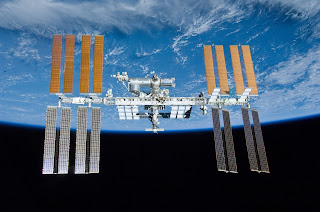VELOCITY
TIME DILATION ON THE INTERNATIONAL SPACE STATION
INTRODUCTION
International Space
Station [ISS] is a satellite orbiting the Earth at a height of 250 miles from
the surface. It completes one revolution around the Earth in approximately 90
Earth minutes. Consider the ISS which revolves at a certain velocity, an
observer [observer 1] on Earth’s surface who also performs circular motion
since Earth is rotating and another observer [observer 2] at the center of
Earth who will not perform circular motion. According to the Special Theory of
Relativity, a clock on ISS would run slower relative to the stationary observer
at the center of Earth. We’ll find the time gained by the ISS and observer 1
with respect to observer 2.
ASSUMPTIONS
- The revolution path is exactly circular.
- Earth is a perfect homogenous sphere.
- The effect of Gravitational time dilation on ISS is negligible.
CALCULATION
The Angular velocity of
Earth
ωe = 2π/Te
[rad/s]
Te –
Rotational time period of Earth [T ≈ 24 hours = 86400s]
ωe =
2*3.14/86400
ωe =
7.2722*10-5 rad/s
The angular velocity is
same at all points on earth since it doesn’t exhibit differential rotation. But
the tangential velocity on surface varies with the distance from the center.
The greater the distance, higher is the velocity. It is important to note that
since ground level observer is also performing a circular motion, he will also
experience time dilation relative to observer at the center of Earth.
The Angular velocity of
ISS
ωi = 2π/Ti
[rad/s]
Ti –
Revolution time period [T ≈ 90 minutes = 5400s]
ωi =
(2*3.14)/5400
ωi = 1.1629*10-3
rad/s
The tangential velocity
of observer at center of Earth is given by,
V0 = [R]*ωe
[m/s]
R – Average radius of
earth [R = 0 m]
V0 = 0 m/s
The tangential velocity
of ground observer is given by,
Ve = [R]*ωe
[m/s]
R – Average radius of
earth [R = 6371000m]
Ve = 6371000*7.2722*10-5
Ve =
463.3118 m/s
The tangential velocity
of ISS is given by,
Vi = [R + h]*ωi
[m/s]
R – Average radius of
earth [R = 6371000m]
h – Height of ISS from
ground [h = 400 km]
Vi =
6771*1000*1.1629*10-3
Vi = 7873.995 m/s
According to the
Special Theory of Relativity, the time dilation equation is,
t’ = t/γ
[s]
t’– ISS time. [s]
t1 – Ground
level observer’s time. [s]
t2 - Proper
time or center of earth observer’s time. [s]
γ – Relativistic gamma
factor, γ = 1/√ [1-(v/c) 2]
c - Velocity of light
[c = 3*108 m/s]
t’ = t*√ [1-(v/c)
2]
Center of Earth
observer time
t2 = t since
v = 0
Ground level observer
time
t1 = t*√ [1-2.3850*10-12]
t1 = t*√ [0.999999999997615]
t1
= t* 0.999999999998808
ISS time
t’ = t*√ [1-6.4448*10-10]
t’ = t*√ [0.99999999935552]
t’ = t* 0.99999999967776
CONCLUSION
We can observe that proper and actual time isn’t
the same which proves that time dilates on revolving ISS relative to the
stationary one. We’ll consider 5 different t’ values and calculate t value. The
larger the t2 the more is the difference between t2 and
t’. Thus ISS will gain time over both observer1 and observer2. In fact in one
year it gains 0.01 second with respect to observer2.
|
Time
|
t2
[Center of Earth observer] (s)
|
t1
[Ground level observer] (s)
|
t’ [Revolving ISS] (s)
|
|
1
minute
|
60
|
59.9999999999285
|
59.9999999806656
|
|
1
hour
|
3600
|
3599.99999999571
|
3599.99999883994
|
|
1
day
|
86400
|
86399.999999897
|
86399.9999721585
|
|
1
month
|
2592000
|
2591999.99999691
|
2591999.99916475
|
|
1
year
|
31536000
|
31535999.9999624
|
31535999.9898378
|

No comments:
Post a Comment